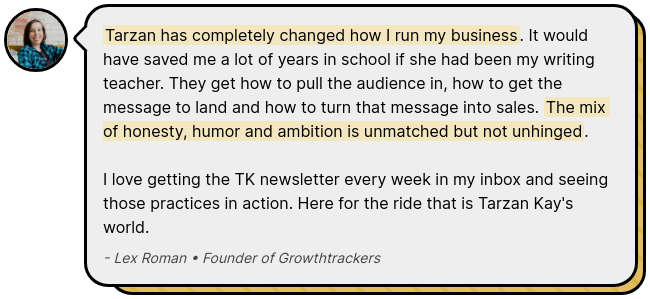Emails, but better.
The Weekly Edition
|
Leave a review and get a prize Write or record a review on Senja Senja is my new favourite tool to noodle around in and avoids work. It grabs my Google reviews and lets me highlight the important bits and turn them into cute testimonial graphics like this (thanks, Lex):
See how it works by leaving me a review (and collecting your prize). Already left me one on Google? Hit “reply” and ask for your prize. |
Inboxes are getting harder to reach
Here’s why that’s a good thing
I have writer’s block today.
Yes, really.
I went through my cold storage file of ideas, but nothing sparked
Next, I combed through the images on my desktop, where I routinely dump screen grabs of email-related issues I may want to write about. The best I could come up with was this unsubscribe confirmation page from beehiiv’s onboarding sequence, which doesn’t have a 1-click unsubscribe.

This annoyed me, but not enough to write a whole email about it.
(Note: 1-click unsubscribe is required by Yahoo and Google’s new deliverability rules. Neither beehiiv nor Substack supports 1-click unsubscribe yet.)
But it got me thinking about all the new rules coming into place for email marketers and newsletter operators and how important they are given the very fast growth of the newsletter industry.
I promise these new inbox rules are good for us.
The easier it is to manage the inbox, the more your subscribers will want to hang out there. That means your deliverability should actually improve based on these new rules, especially for those of us who are operating from a place of consent.
Here’s the TL;DR in case you don’t feel like geeking out on email today:
All roads lead to back consent. Subscribers don’t want to deal with emails they don’t remember signing up for (even if they actually did).
Gmail’s Latest Trick 

There’s a rumor that Gmail is about to unveil a subscription management page – a sidebar option that will identify which companies are sending “too many emails.” (Read: too many lackluster emails about things you’re not interested in and never signed up for.)
If the rumor holds, Gmail users will be able to filter emails based on how many they receive per quarter from that sender. Built-in frequency controls! I love this, though it’s better to offer this to your subscribers on your end so that you can choose what emails your monthly subscribers get rather than Google choosing for you.
Let’s not forget Gmail already added a handy blue unsubscribe link in large font at the top of every marketing email, making it easier for people to unsubscribe (Again, a good thing—you don’t want to be sending emails to people who don’t want them. It’s bad for deliverability.)
I use Superhuman [affiliate link] for inbox management, which has the same feature, albeit in a slightly less conspicuous gray font.

These changes are important and necessary.
Newsletters are having a moment right now. It’s easier (and cheaper!) than ever to design a beautiful newsletter—not so much the writing part, but we’ll save that for another day. Recommendation widgets and other referral engines are making it easier than ever to grow if you have the right partnerships and capital to spend on ads.
But here’s the rub:
The easier it is to subscribe to an email list, the less committed your new subscriber is going to be. Easy come, easy go. A subscriber that comes through a recommendations pop-up like Creator Network or Upscribe, for example, doesn’t have the same level of intent as one who came from a newsletter opt-in page and knows a lot more about whose emails they’ve opted in for.
Substack, beehiiv, Ghost, and ConvertKit all have this functionality. It pops up after you hit “subscribe” and looks something like this:

Notice how the boxes are automatically ticked, and the “maybe later” button is deprioritized? It’s easy to accidentally subscribe to a bunch of newsletters you’ve never heard of and don’t want.
Sandra Booker and I decided that we won’t presume consent from subscribers who come through a recommendation widget. Sandra reports that since her clients started using Upscribe, she’s seeing an enormous influx of replies from subscribers asking, “Who are you, and how did I get on this email list?”
That’s bad for deliverability.
Some people will reply and say, “What the hell, man?” but most will either ignore or quietly send you to spam.
Our fix? We’ve decided to send those subscribers a welcome sequence that offers plenty of opportunities to explicitly consent to the newsletter. But if they don’t consent, they won’t ever get the newsletter and eventually they’ll get scrubbed.
The Bottom Line
Email isn’t the numbers game that people think it is, especially not for small-list superheroes like us. ![]()
![]()
![]()
Subscriber engagement is much more important than the size of your list. That’s what Google and Yahoo are looking for. Does it seem like the user actually wants these emails? Do they open them, read them, forward them, or (the holiest of holies) reply to them?
Subscribers who consistently click your links and reply to your emails are unlikely to magically get rolled up into a once-per-month subscription managed by Gmail on the subscriber’s end.
A few things you can do to nurture those kinds of subscribers:
1. Ask for replies.
Ask a simple question that doesn’t require too much forethought, or ask subscribers to hit reply and say, “I want Sheila’s emails!” to ensure that the emails get delivered. (Something they’re unlikely to do if they came through a recommendations widget because how could they possibly know?)
When a subscriber replies, it automatically improves your inbox placement. Not forever, but it’s a great way to start a new subscriber relationship.
Good question → “What’s 1 business strategy that makes your stomach turn?” (Negativity bias makes annoying strategies easier to remember and call up quickly. My vote is bundles.)
Bad question → “What’s your biggest struggle when it comes to lead gen?” (Uhh…let me click away while I sort through 45 possible answers. I will never return to this.)
2. Send a welcome sequence.
Sending subscribers straight to your newsletter doesn’t usually make sense. It’s jarring. It’s like French kissing before the appetizers have been delivered. Write this minimum viable welcome sequence that tells your new subscriber what to expect:
Email 1 → Remind them who you are and where they signed up. Assume they forgot immediately after hitting “subscribe” because they probably did.
Email 2 → Tell them what kinds of things you write about and how often.
3. Educate subscribers on deliverability.
This won’t work for subscribers who subscribed via a widget and aren’t even sure they want your emails. But for those who proactively subscribed after, say, hearing you on a podcast or reading something you wrote on LinkedIn, it’s important.
Here’s what this looks like in one of my welcome sequences:

Wanna make sure you get these emails each week? Here’s how to train your inbox.
First, hit “reply” and type literally anything. Tell me who referred you? (I have a lot of fans because I am very smart, important, and beautiful.)
Second,
Gmail users, drag me into your primary tab to make sure you receive my Tuesday newsletter.
- On mobile: In the top right corner of the app, hit those 3 dots, tap “Move to” then “Primary”
- On desktop: Go back, then drag and drop this email into the “Primary” tab. It should be the first on the left.

Apple users, tap on my email address at the top of this email and click “Add to VIPs.”

With so many low-commitment subscribers who join by ticking a box or through a form that is auto-filled, the double opt-in is ripe for a comeback.
You heard it here first!
What I want you to take away from this email is that you should not feel intimidated by these new rules around email. They are pointing in the same direction I am ![]()
CONSENT-BASED MARKETING!
When you email people who don’t want to hear from you, it damages your deliverability. It’s going to be more and more difficult for those emails to reach inboxes anyway.
But I’m willing to bet that’s not you.
It’s easy to forget when you’re wrestling with “do these people even care what I have to say” that they actually did raise their hand and say yes to your emails.
Don’t forget that when you’re writing your next email. You are not an abandon-cart autoresponder; you’re a person. A person who has been given a temporary hall pass into the inboxes of your subscribers.
When you email people who gave you that hall pass i.e. who explicitly consented to be added to your email list, you get rewarded with premium inbox placement, and the kinds of subscribers who share your work, refer other subscribers, and one day become your customers.
…which is the only kind of subscribers we should all be after.
Stepping off my soapbox ![]()
T-Boss
|


